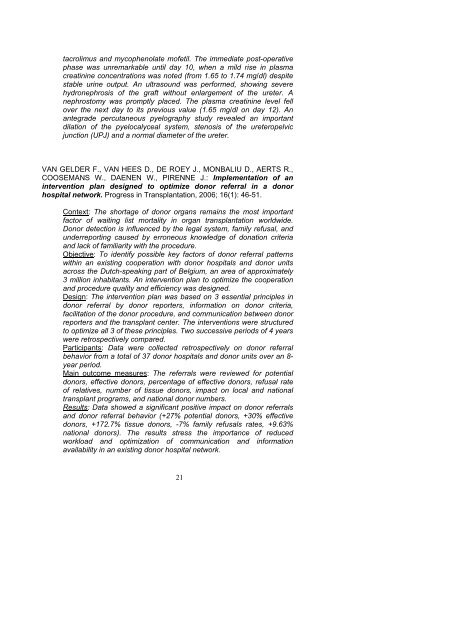2006 - UZ Leuven
2006 - UZ Leuven
2006 - UZ Leuven
You also want an ePaper? Increase the reach of your titles
YUMPU automatically turns print PDFs into web optimized ePapers that Google loves.
tacrolimus and mycophenolate mofetil. The immediate post-operativephase was unremarkable until day 10, when a mild rise in plasmacreatinine concentrations was noted (from 1.65 to 1.74 mg/dl) despitestable urine output. An ultrasound was performed, showing severehydronephrosis of the graft without enlargement of the ureter. Anephrostomy was promptly placed. The plasma creatinine level fellover the next day to its previous value (1.65 mg/dl on day 12). Anantegrade percutaneous pyelography study revealed an importantdilation of the pyelocalyceal system, stenosis of the ureteropelvicjunction (UPJ) and a normal diameter of the ureter.VAN GELDER F., VAN HEES D., DE ROEY J., MONBALIU D., AERTS R.,COOSEMANS W., DAENEN W., PIRENNE J.: Implementation of anintervention plan designed to optimize donor referral in a donorhospital network. Progress in Transplantation, <strong>2006</strong>; 16(1): 46-51.Context: The shortage of donor organs remains the most importantfactor of waiting list mortality in organ transplantation worldwide.Donor detection is influenced by the legal system, family refusal, andunderreporting caused by erroneous knowledge of donation criteriaand lack of familiarity with the procedure.Objective: To identify possible key factors of donor referral patternswithin an existing cooperation with donor hospitals and donor unitsacross the Dutch-speaking part of Belgium, an area of approximately3 million inhabitants. An intervention plan to optimize the cooperationand procedure quality and efficiency was designed.Design: The intervention plan was based on 3 essential principles indonor referral by donor reporters, information on donor criteria,facilitation of the donor procedure, and communication between donorreporters and the transplant center. The interventions were structuredto optimize all 3 of these principles. Two successive periods of 4 yearswere retrospectively compared.Participants: Data were collected retrospectively on donor referralbehavior from a total of 37 donor hospitals and donor units over an 8-year period.Main outcome measures: The referrals were reviewed for potentialdonors, effective donors, percentage of effective donors, refusal rateof relatives, number of tissue donors, impact on local and nationaltransplant programs, and national donor numbers.Results: Data showed a significant positive impact on donor referralsand donor referral behavior (+27% potential donors, +30% effectivedonors, +172.7% tissue donors, -7% family refusals rates, +9.63%national donors). The results stress the importance of reducedworkload and optimization of communication and informationavailability in an existing donor hospital network.21

















